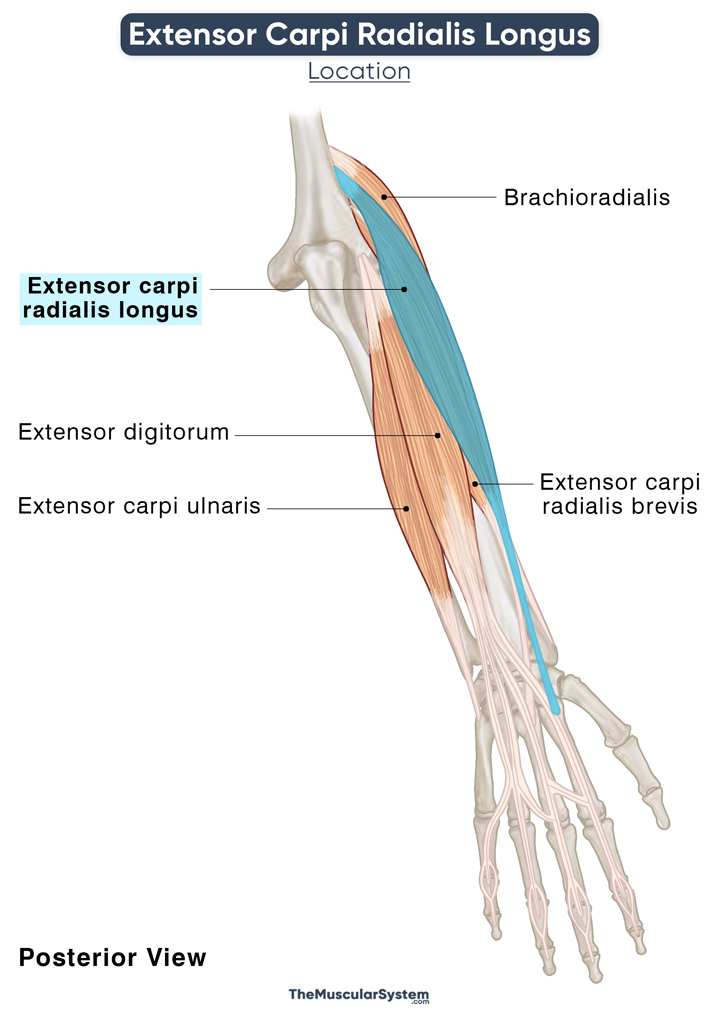Extensor Carpi Radialis Longus
Last updated:
05/05/2023Della Barnes, an MS Anatomy graduate, blends medical research with accessible writing, simplifying complex anatomy for a better understanding and appreciation of human anatomy.
What is Extensor Carpi Radialis Longus
The extensor carpi radialis longus (ECRL) is a thin long superficial muscle in the posterior compartment of the forearm. It is one of the 3 muscles that form the radial group of wrist extensors, also known as the mobile wad of Henry, along with the brachioradialis and extensor carpi radialis brevis.
It is a fusiform muscle and one of the primary movers of the wrist and hand.
Anatomy
Location and Attachments
| Origin | Distal third of the lateral supracondylar ridge of the humerus |
| Insertion | The posterior surface of the 2nd metacarpal base |
Origin
Like the other two muscles in the radial group, the extensor carpi radialis longus originates from the distal (lower) part of the humerus’s lateral supracondylar ridge. The lateral intermuscular septum in this area acts as a secondary point of origin. At the same time, the common extensor tendon on the lateral epicondyle of the humerus also gives rise to a few muscle fibers.
Insertion
As the origin tendons run distally, they converge and broaden to form the thick muscle belly. This belly narrows back into a flat tendon as it reaches the middle of the forearm and continues down along the radius on its lateral border, alongside the extensor carpi radialis brevis tendon. These two tendons course deep to the abductor pollicis longus and extensor pollicis brevis to make their way to the styloid process of the radius.
The ECRL tendon passes underneath the dorsal carpal ligament and behind the styloid process. It enters the common synovial sheath just before the wrist and passes through the shallow groove at the back of the radius. The extensor carpi radialis longus tendon is accompanied by the extensor carpi radialis brevis tendon.
Here, the extensor pollicis longus tendon crosses the extensor carpi radialis longus tendon. The latter travels further down to insert at the back of the 2nd metacarpal base, on the radial (thumb) side.
Relations With Surrounding Muscles and Structures
When you keep your arm in the anatomical position (palms facing forward), the extensor carpi radialis longus is the most lateral muscle, while the extensor carpi radialis brevis, extensor carpi ulnaris, and extensor digitorum lie medially. ECRL can be palpated at the back of the elbow, just below the joint.
Since it is a superficial muscle, it has all the deep posterior forearm flexors lying underneath. The muscle belly of the anconeus in the posterior upper arm also lies deep to the extensor carpi radialis longus. Brachioradialis, another radial wrist extensor, partially overlaps the ECRL, while the brachialis lies medially.
The radial nerve runs between the extensor carpi radialis longus and brachioradialis near the wrist, just before the styloid process of the radius.
Function
| Action | Extension and abduction of the hand at the wrist joint |
Extending the Wrist
As evident from its name, it is one of the primary muscles for wrist extension. Extending the wrist means bending your wrist backward so your palm faces the front like you do when making the ‘Stop’ sign. The extensor carpi ulnaris and extensor carpi radialis brevis also act alongside the extensor carpi radialis longus
Abducting the Hand at the Wrist
It works with the flexor carpi radialis to abduct the hand at the wrist joint, a movement known as radial deviation. It means bending the wrist to the side of the thumb. For example, when you move your hand from side to side to say goodbye to someone, the ECRL is active when the hand bends on the thumb side.
The above two movements together allow for several intricate functioning of the hands.
Flexing the Elbow
It is a minor function, as part of the mobile wad of Henry along with extensor carpi radialis brevis and brachioradialis. These three muscles help flex or bend the arm at the elbow joint.
Strengthening a Grip
Together with the other extensors, it also plays an important, indirect role in gripping hand movements. The wrist must be stable in an extended position with no flexion to grip something properly. Because only once the wrist is locked in this position, the contraction force of the forearm flexors can be transferred to the fingers, resulting in a powerful grip.
The primary antagonist of extensor carpi radialis longus is the superficial muscle in the anterior forearm, the flexor carpi ulnaris.
Innervation
| Nerve | Radial nerve (C6 and C7), a branch of the brachial plexus |
Blood Supply
| Artery | Radial artery |
The primary blood supply comes from the radial artery, supplying the muscle directly on its distal side. The proximal part of the muscle receives blood supply from the radial recurrent artery, a branch of the radial artery.
Another additional supply comes from the radial collateral artery, a branch of the brachial artery.
References
- Extensor Carpi Radialis Longus: Origin, Insertion & Innervation: Study.com
- Extensor Carpi Radialis Longus: TeachMeAnatomy.info
- Extensor Carpi Radialis Longus Muscle: KenHub.com
- Extensor Carpi Radialis Longus: IMAIOS.com
- What Is the Extensor Carpi Radialis Longus?: WebMD.com
- Extensor Carpi Radialis Longus: HealthLine.com
- Extensor Carpi Radialis Longus: Rad.Washington.edu
- Extensor Carpi Radialis Longus: GetBodySmart.com
Della Barnes, an MS Anatomy graduate, blends medical research with accessible writing, simplifying complex anatomy for a better understanding and appreciation of human anatomy.
- Latest Posts by Della Barnes, MS Anatomy
-
Inferior Pharyngeal Constrictor
- -
Middle Pharyngeal Constrictor
- -
Superior Pharyngeal Constrictor
- All Posts







